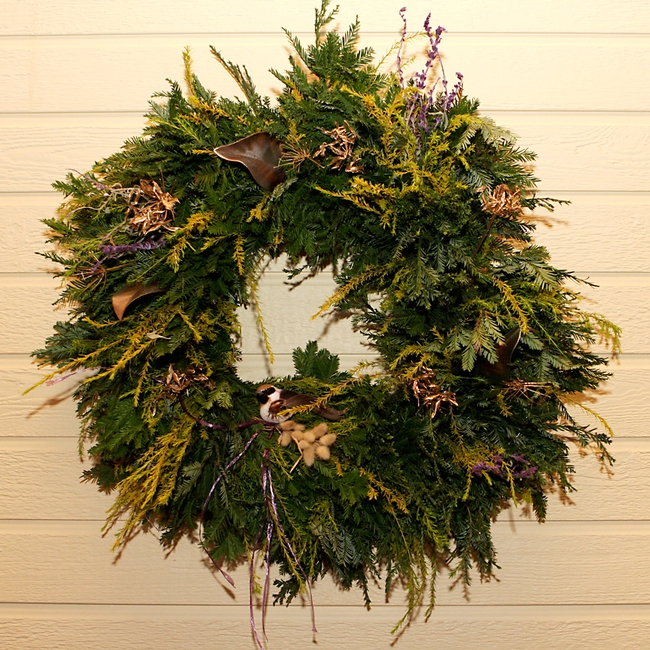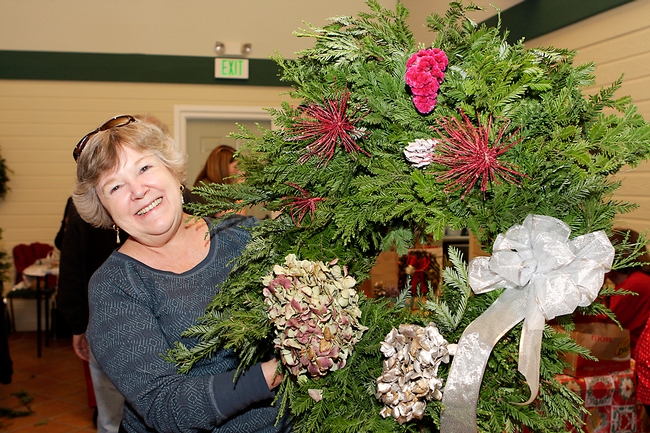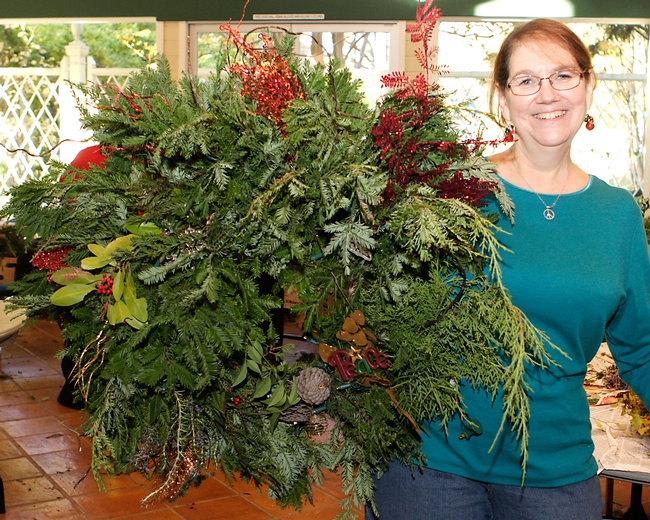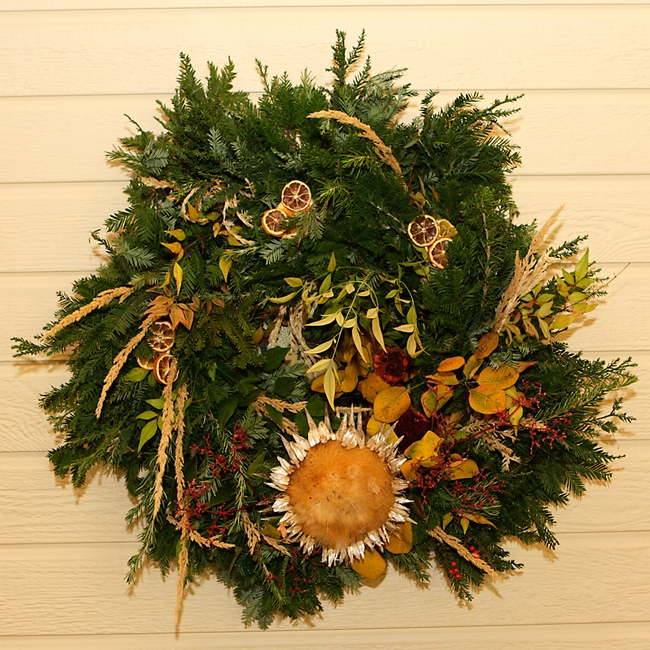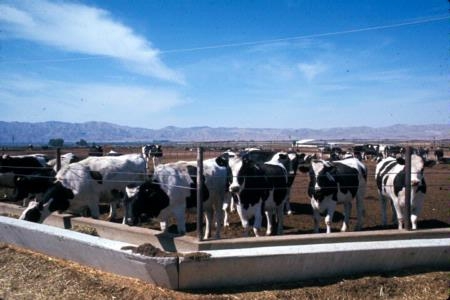UC Blogs
Wreaths-the follow up
Well, on December 3, the Master Gardeners celebrated their 21st Wreath Workshop. There were 40 wreath makers in attendance and they created some of the most fabulous wreaths! Each were given a box of redwood, a wire wreath frame and paddle wire. They could also choose from 'extra' greens, which were: heavenly bamboo (Nandina domestica), Breath of Heaven (Coleonema spp.), Sweet bay (Laurus nobilis), Eucalyptus, Rosemary (Rosmarinus officinalis), Lavender (Lavandula spp.), and Yew (Podocarpus gracilior)-to name a few. Each person had access to the same materials, along with natural decorations, but each wreath came out very unique-especially to that persons' creativity. Below is a sampling of the wreaths made at the event this year.
Beer for a Butterfly
Beer for a butterfly. Now that's an interesting concept. That’s what you’ll get—or the cash equivalent—if you collect the first cabbage white...
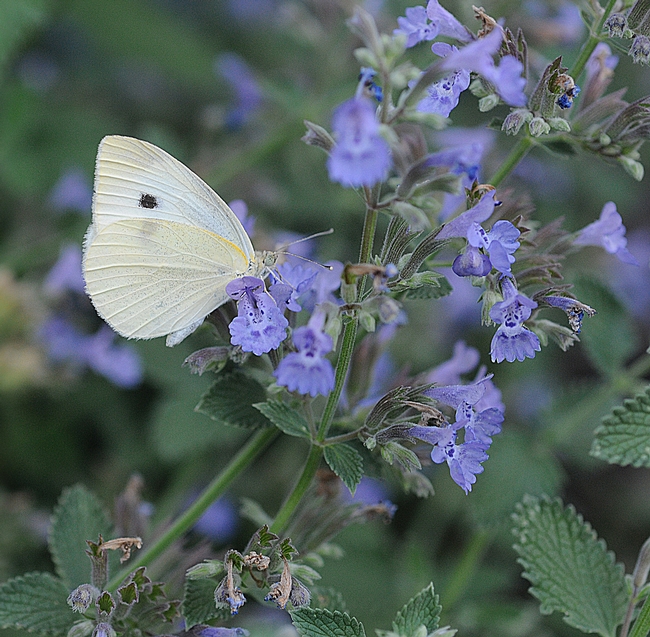
Cabbage white butterfly (Pieris rapae) on catmint. (Photo by Kathy Keatley Garvey)
Royalty Plus
Call it a case of royalty plus. UC Davis chemical ecologist Walter Leal, professor and former chair of the UC Davis Department of Entomology, has...

Chemical ecologist Walter Leal in front of a silkworm moth depiction. (Photo by Kathy Keatley Garvey)
Biodynamic Gardening and Agriculture
Disclaimer: This article does not express the views held or advocated by UCCE or its affiliates with regard to biodynamic gardening or farming. It only seeks to introduce the concept of biodynamics to readers as another alternative system of sustainable gardening.
For all of you gardening enthusiasts (which I assume all of you are, since you are reading this blog), it is likely that at some point, you have come across the term “biodynamic” gardening or farming.
Biodynamic gardening/farming is usually regarded as one of the earliest organized systems of organic gardening, emphasizing the interrelationships between soil, plant and livestock management (i.e., the garden or farm is regarded as an organism). The foundation for biodynamic gardening or farming arises from a series of lectures given in 1924 by the Austrian philosopher, Rudolf Steiner, to farmers seeking his assistance. Perhaps the defining feature of biodynamic gardening/agriculture and what people find most intriguing, is the use of what is known as “preparations,” (of which there are nine (9), divided between field and compost preparations) which generally consist of manure and/or specific flowers/herbs fermented in a vessel such as a cow horn or the bladder of a red deer/elk, as applicable. The preparations are typically diluted with water, stirred in an exacting manner for a specific period of time, and then sprayed onto a field or compost to stimulate plant growth, as appropriate, and microbial activity. Although these preparations sound esoteric and inaccessible to the average person, people seeking to incorporate biodynamic methods in their garden, may purchase preparations from biodynamic trade organizations and/or other biodynamic gardeners and farmers.
The popularity of biodynamics has gained steam in the mainstream, as many wineries, both local (some even in Napa and Sonoma Counties!) and abroad, have adopted such practices.
For further information on biodynamic gardening or farming, please feel free to visit https://attra.ncat.org/attra-pub/summaries/summary.php?pub=290 or google the term, “biodynamic gardening,” “biodynamic farming,” or “biodynamic agriculture.”
California conservation tillage acreage increasing
The amount of California farmland being cultivated using conservation tillage techniques is continuing to expand, according to a survey by California’s Conservation Agriculture Systems Institute (CASI).
The survey tallies silage and grain corn; small grains for hay, silage and grain; tomatoes, cotton, dry beans, and melons managed as no-till, strip-till, ridge-till and mulch-till – which leave at least 30 percent of residue from the previous crops on the soil surface – in the nine-county Central Valley region. In 2010, such conservation tillage accounted for about 14 percent of the crops’ total acreage, an increase from about 10 percent in 2008. The survey also found that minimum tillage practices – which reduce the overall number of tillage passes by at least 40 percent relative to what was done in 2000 – were used on about 33 percent of crop acreage in 2010, up from about 21 percent in 2008.
There are many potential benefits for using conservation tillage, said UC Cooperative Extension cropping systems specialist Jeff Mitchell. Conservation tillage is credited with water conservation, dust suppression, reduced pesticide runoff into surface water, lowered labor needs and costs, and fuel savings. In addition, limiting tillage helps to keep carbon in the ground and prevent the buildup of greenhouse gases in the atmosphere.
CASI has conducted comparisons of annual row crop acreage farmed under different tillage systems in the Central Valley region since 2004. More than 35 Natural Resources Conservation Service, University of California and private sector experts take part in the survey.
The largest change in conservation tillage acreage from 2004 to 2010 is found in the amount of corn silage acreage that uses strip-tillage. In 2004, there were only about 490 acres of summer silage corn using strip-till, while in 2010 more than 103,000 acres in the San Joaquin Valley dairy region had adopted this form of conservation tillage. The overall use of minimum tillage practices has also greatly increased during this time from about 64,000 acres under reduced pass tillage in 2004 and just over 700,000 acres under minimum tillage in 2010.
California’s Conservation Agriculture Systems Institute involves more than 1,500 farmers, industry representatives, university, Natural Resource Conservation Service and other public agency members. Over the past 10 years, the team has come together to develop information on the costs and benefits of the production system and irrigation management alternatives and to develop long-term sustainability goals. For more information on the body of CT research, see the UC Conservation Tillage website.


